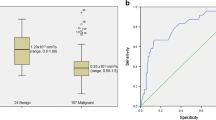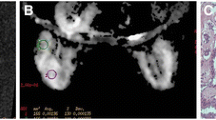Abstract
Purpose
This study assessed the usefulness of magnetic resonance diffusion-weighted imaging (DWI) in distinguishing between benign and malignant breast lesions.
Materials and methods
Gadolinium-enhanced magnetic resonance imaging (MRI) and DWI with determination of the apparent diffusion coefficient (ADC) were performed on 78 women, each with a focal breast lesion at least 7 mm in diameter, which was studied by cytology or histology.
Results
Final diagnoses were obtained by cytology in 29 cases and histology in 49 (11 percutaneous biopsies and 38 surgical specimens). There were 43 benign lesions (13 fibrocystic disease, eight fibroadenoma, seven adenosis, five normal breast tissue, four inflammatory lesions, three intramammary lymph nodes, two scleroelastosis and one fat necrosis) and 35 malignant lesions (30 invasive ductal carcinoma, two invasive lobular carcinoma, one ductal carcinoma in situ, one carcinomatous mastitis and one metastasis from neuroendocrine carcinoma). The mean ADC values were 1.677±0.151 for benign lesions and 1.298±0.129 for malignant lesions (p<0.001). With an ADC cutoff value of 1.48, DWI had 88.6% sensitivity [confidence interval (CI) 78.1%–99.1%] and 95.3% specificity (CI 88.9%–100%), with 31 true positives, four false negatives (three invasive ductal carcinoma and one carcinomatous mastitis), 41 true negatives and two false positives (one fat necrosis and one fibroadenoma). With the cutoff value set at 1.52, DWI sensitivity (35 true positive, no false negative) was 100% and specificity was 86% (CI 75.7%–96.3%) due to 37 true negatives and six false positives (an additional two fibroadenoma and two fibrocystic disease compared with those recorded with the cutoff set at 1.48). The overall accuracy of DWI considering both cutoff values (72 correct evaluations out of 78 cases) was 92.3% (CI 86.4%–98.2%).
Conclusions
DWI is a reliable tool for characterising focal breast lesions.
Riassunto
Obiettivo
Scopo del nostro lavoro è stato stabilire l’utilità dell’imaging in risonanza magnetica (RM) pesata in diffusione (DWI) nel distinguere le lesioni mammarie benigne da quelle maligne.
Materiali e metodi
La RM con mezzo di contrasto e la DWI, con misurazione del coefficiente di diffusione apparente (ADC), sono state eseguite in 78 pazienti di sesso femminile, ognuna portatrice di una lesione focale della mammella con diametro di almeno 7 mm sottoposta ad indagine citologica o bioptica.
Risultati
La diagnosi finale è stata ottenuta mediante citologia in 29 casi ed istologia in 49 (11 biopsie percutanee e 38 pezzi operatori). 43 lesioni sono risultate benigne (13 casi di mastopatia fibrocistica, 8 di fibroadenoma, 7 di adenosi, 5 di tessuto mammario normale, 4 di lesioni flogistiche, 3 di linfonodi intramammari, 2 di scleroelastosi ed 1 di steatonecrosi) e 35 maligne (30 carcinomi duttali infiltranti, 2 carcinomi lobulari infiltranti, 1 carcinoma duttale in situ, 1 mastite carcinomatosa ed 1 metastasi da carcinoma neuroendocrino). I valori medi di ADC sono risultati di 1,677±0,151 per le lesioni benigne e di 1,298±0,129 per quelle maligne (p<0,001). Ponendo il cut off di ADC pari a 1,48, la DWI ha raggiunto una sensibilità (31 veri positivi; 4 falsi negativi, rappresentati da 3 carcinomi duttali infiltranti e da una mastite carcinomatosa) dell’88,6% (intervallo di confidenza [IC]: 78,1%–99,1%) ed una specificità (41 veri negativi; 2 falsi positivi, dovuti ad un caso di steatonecrosi e ad un fibroadenoma) del 95,3% (IC: 88,9%–100%). Con il cut off di 1,52, la sensibilità (35 veri positivi; nessun falso negativo) è risultata del 100% e la specificità (37 veri negativi; 6 falsi positivi, per l’aggiunta ai due falsi positivi riscontrati con cut off di 1,48 di 2 fibroadenomi e 2 casi di mastopatia fibrocistica) dell’86% (IC: 75,7%–96,3%). Con entrambi i cut off l’accuratezza globale della DWI (72 risultati esatti su 78 casi) è stata del 92,3% (IC: 86,4%–98,2%).
Conclusioni
La DWI è uno strumento affidabile nella tipizzazione delle lesioni focali mammarie.
Similar content being viewed by others
References/Bibliografia
Liu PF, Debatin JF, Caduff RF et al (1998) Improved diagnostic accuracy in dynamic contrast enhanced MRI of the breast by combined quantitative and qualitative analysis. Br J Radiol 71:501–509
Sinha S, Lucas-Quesada FA, Debruhl ND et al (1997) Multifeature analysis of Gd-enhanced MR images of breast lesions. J Magn Reson Imaging 7:1016–1026
Sardanelli F, Giuseppetti GM, Canavese G et al (2008) Indications for breast magnetic resonance imaging. Consensus Document “Attualità in Senologia”, Florence 2007. Radiol Med 113:1085–1095
Bluemke DA, Gatsonis CA, Chen MH et al (2004) Magnetic resonance imaging of the breast prior to biopsy. JAMA 292:2735–2742
Boetes C, Barentsz JO, Mus RD et al (1994) MR characterization of suspicious breast lesions with a gadoliunium-enhanced TurboFLASH subtraction technique. Radiology 193:777–781
Buadu LD, Murakami J, Murayama S et al (1996) Breast lesions: correlation of contrast medium enhancement patterns on MR images with histopathologic findings and tumor angiogenesis. Radiology 200:639–649
Gilles R, Guinebretiere JM, Lucidarme O et al (1994) Nonpalpable breast tumors: diagnosis with contrast.enhanced subtraction dynamic MR imaging. Radiology 191:625–631
Siegmann KC, Mueller-Schimpfle M, Schick F et al (2002) MRI imaging-detected breast lesion: histopathologic correlation of lesion characteristics and signal intensity data. AJR Am J Roentgenol 178:1403–1409
Esserman L, Hylton N, Yassa L et al (1999) Utility of magnetic resonance imaging in the management of breast cancer: evidence for improved preoperative staging. J Clin Oncol 17:110–119
Gundry KR (2005) The application of breast MRI in staging and screening for breast cancer. Oncology 19:159–169
Kuhl CK, Mielcareck P, Klaschik S et al (1999) Dynamic breast MR imaging: are signal intensity time course data useful for differential diagnosis of enhancing lesions? Radiology 211:101–110
Morris EA, Liberman L, Ballon DJ et al (2003) MRI of occult breast carcinoma on a high-risk population. AJR Am J Roentgenol 181:619–626
Orel SG, Schnall MD (2001) MR imaging of the breast for the detection, diagnosis, and staging of breast cancer. Radiology 220:13–30
Guo Y, Cai YQ, Cai ZL et al (2002) Differentiation of clinically benign and malignant breast lesions using diffusion-weighted imaging. J Magn Reson Imaging 16:172–178. DOI 10.1002/jmri.10140
Hatakenaka M, Soeda H, Yabuuchi H et al (2008) Apparent diffusion coefficients of breast tumors: clinical application. Magn Reson Med Sci 7:23–29
Park MJ, Cha ES, Kang BJ et al (2007) The role of diffusion-weighted imaging and the apparent diffusion coefficient (ADC) values for breast tumors. Kor J Radiol 8:390–396
Huang W, Fisher PR, Dulaimy K et al (2004) Detection of breast malignancy: diagnostic MR protocol for improved specificity. Radiology 232:585–591
Kinkel K, Helbich TH, Esserman LJ et al (2000) Dynamic high-spatial-resolution MR imaging of suspicious breast lesions: diagnostic criteria and interobserver variability. AJR Am J Roentgenol 175:35–43
Kuroki Y, Nasu K, Kuroki-Suzuki S et al (2004) Diffusion-weighted imaging of breast cancer with the sensitivity encoding technique: analysis of the apparent diffusion coefficient value. Magn Reson Med Sci 3:79–85
Nasu K, Kuroki Y, Nawano S et al (2006) Hepatic metastases: diffusion-weighted sensitivity-encoding versus SPIO-enhanced MR imaging. Radiology 239:122–130
Kuroki-Suzuki S, Kuroki Y, Nasu K et al (2007) Detecting breast cancer with non-contrast MR Imaging: combining diffusion-weighted and STIR imaging. Magn Reson Med Sci 6:21–27
Schmithorst VJ, Dardzinski BJ, Holland SK (2001) Simultaneous correction of ghost and geometric distortion artifacts in EPI using a multiecho reference scan. IEEE Trans Med Imaging 20:535–539
Matsuoka A, Minato M, Harada M et al (2008) Comparison of 3.0- and 1.5-tesla diffusion-weighted imaging in the visibility of breast cancer. Radiat Med 26:15–20. DOI 10.1007/s11604-007-0187-6
Bammer R (2003) Basic principles of diffusion-weighted imaging. Eur J Radiol 45:169–184
Ichikawa T, Haradome H, Hachiya J et al (1998) Diffusion-weighted MR imaging with single-shot echoplanar sequence: detection and characterization of focal hepatic lesions. AJR Am J Roentgenol 170:397–402
Kim T, Muratami T, Takahashi S et al (1999) Diffusion weighted single-shot echoplanar MR imaging for liver disease. AJR Am J Roentgenol 173:393–398
Moteki T, Ishizaka H (2000) Diffusionweighted EPI of cystic ovarian lesions: evaluation of cystic contents using apparent diffusion coefficients. J Magn Reson Imaging 12:1014–1019
Sinha S, Lucas-Quesada FA, Sinha U et al (2002) In vivo diffusion-weighted MRI of the breast: potential for lesion characterization. J Magn Reson Imaging 15:693–704
Woodhams R, Matsunaga K, Kan S et al (2005) ADC mapping of benign and malignant breast tumors. Magn Reson Med Sci 4:35–42
Yamada I, Aung W, Himeno Y et al (1999) Diffusion coefficients in abdominal organs and hepatic lesions: evaluation with intravoxel incoherent motion echo-planar MR imaging. Radiology 210:617–623
Yabuuchi H, Matsuo Y, Okafuji T et al (2008) Enhanced mass on contrast-enhanced breast MR imaging: lesion characterization using combination of dynamic contrast-enhanced and diffusion-weighted MR images. J Magn Reson Imaging 28:1157–1165. DOI 10.1102/jmri.21570
Pilatus U, Shim H, Artemov D et al (1997) Intracellular volume and apparent diffusion constants of perfused cancer cell cultures, as measured by NMR. Magn Reson Med 37:825–832
Sinha S, Sinha U (2002) Functional magnetic resonance of human breast tumors: diffusion and perfusion imaging. Ann NY Acad Sci 980:95–115
Kinoshita T, Yashiro N, Ihara N et al (2002) Diffusion-weighted half-Fourier single-shot turbo spin echo imaging in breast tumors: differentiation of invasive ductal carcinoma from fibroadenoma. J Comput Assist Tomogr 26:1042–1046
Rubesova E, Grell AS, De Maertelaer V et al (2006) Quantitative diffusion imaging in breast cancer: a clinical prospective study. J Magn Reson Imaging 24:319–324
Woodhams R, Matsunaga K, Iwabuchi K et al (2005) Diffusion-weighted imaging of malignant breast tumors: the usefulness of apparent diffusion coefficient (ADC) value and ADC map for the detection of malignant breast tumors and evaluation of cancer extension. J Comput Assist Tomogr 29:644–649
Le Bihan D Breton E, Laillemand D et al (1986) MR imaging of intravoxel incoherent motions: application to diffusion and perfusion in neurologic disorders. Radiology 161:401–407
Lyng H, Haraldseth O, Rofstad EK (2000) Measurement of cell density and necrotic fraction in human melanoma xenografts by diffusion weighted magnetic resonance imaging. Magn Reson Med 43:828–836
Yoshikawa MI, Ohsumi S, Sugata S et al (2008) Relation between cancer cellularity and apparent diffusion coefficient values using diffusion-weighted magnetic resonance imaging in breast cancer. Radiat Med 26:222–226
Author information
Authors and Affiliations
Corresponding author
Rights and permissions
About this article
Cite this article
Fornasa, F., Pinali, L., Gasparini, A. et al. Diffusion-weighted magnetic resonance imaging in focal breast lesions: analysis of 78 cases with pathological correlation. Radiol med 116, 264–275 (2011). https://doi.org/10.1007/s11547-010-0602-4
Received:
Accepted:
Published:
Issue Date:
DOI: https://doi.org/10.1007/s11547-010-0602-4




